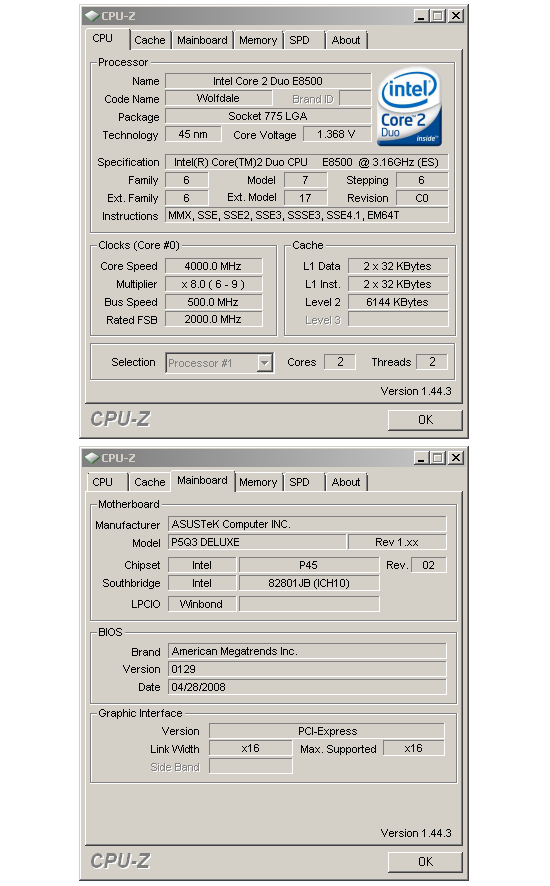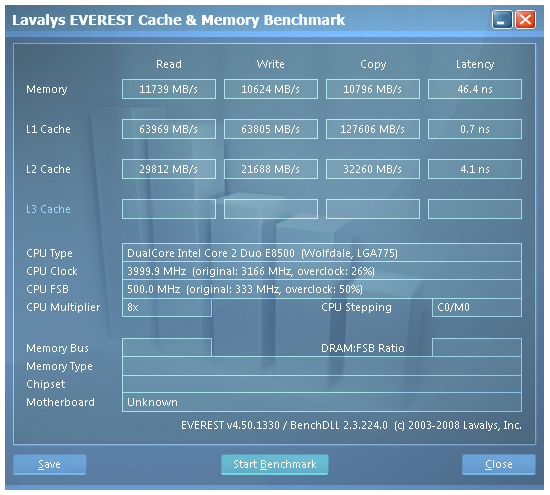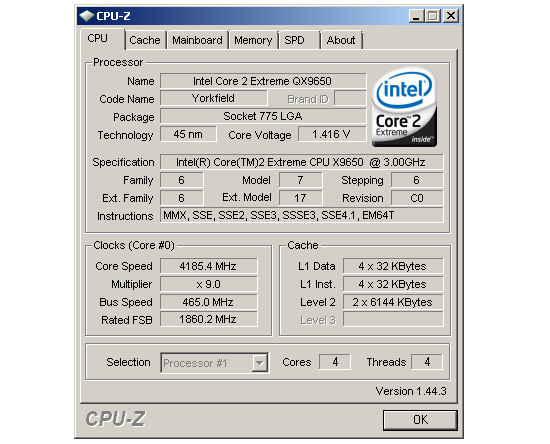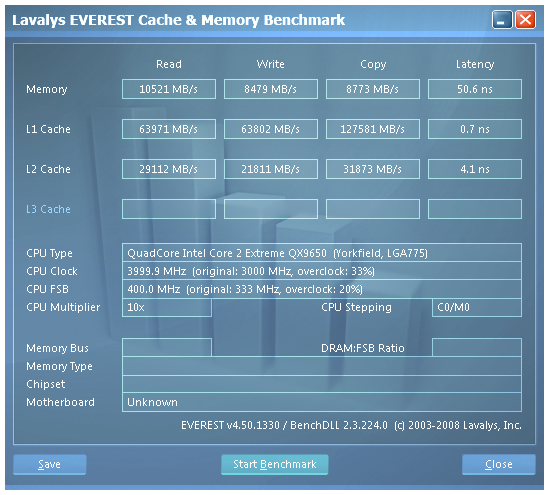ASUS P5Q3 Deluxe: An Early Preview of P45 Express Performance
by Kris Boughton on May 13, 2008 2:00 PM EST- Posted in
- Motherboards
Just a Taste of Early Overclocking Results
Because our ASUS P5Q3 Deluxe motherboard was built using early P45 silicon (revision A2), we believe it to be entirely appropriate to reserve final judgment of the board's overclockability until such time as retail products are ready for release. With that being said, we also want to bring you an early look at our first attempts at overclocking the P5Q3 Deluxe.

Achieving 4.0GHz with a dual-core Core2 E8500 was breeze thanks to our ASUS P5Q3 Deluxe.

Lavalys EVEREST had trouble identifying our motherboard, but the results are 100% accurate.
Using an E8500 we were able to push to 500FSB, albeit with more vMCH than we expected - nearly 1.5V was needed for sustained stability. This is precisely one of the reasons that we would like to withhold our final opinions on the overclocking merits of this board. We know there is a new P45 silicon spin in the works (revision A3) and thermal and power characteristics generally improve as each new product's process improves. In the meantime, our results at least offer us hope that P45 has the potential to outshine even P35, which has proven to be an amazingly overclockable chipset.

Our maximum FSB overclock with a tRD (Static Read Delay) of 7 using our QX9650 was great considering our relative inexperience working with P45.
We decide to see how far we could push the board at a tRD of 7 (about 465FSB). Going any higher required a switch to a tRD of 8, leaving valuable memory performance on the table whilst only giving us a couple more megahertz before our quad-core CPU ran out of steam. We are more than happy with this result though as 465FSB is still the sweet spot for a lot of boards when using anything with more than two cores.

Latencies around 50ns and read scores well above 10GB/s are a real treat when playing with a quad-core CPU.
Our preferred operating point, 10x400, is looking good with P45. Given this, it might be hard to justify the extra expense of an X48 board if all we plan on doing is light gaming with the best CPU we can afford. Later, if we decide we need more 3D graphics power, we can always drop in another GPU as long as we're smart about it and start with a CrossFire-ready graphics card.










30 Comments
View All Comments
DigitalFreak - Tuesday, May 13, 2008 - link
Didn't bother to even read the article, did you?JarredWalton - Tuesday, May 13, 2008 - link
See the conclusion. As always, SLI requires an NVIDIA chipset to work. This board does support CrossFire however - in 2x8 PCIe 2.0 configuration, which matches the bandwidth of 2x16 PCIe 1.x seen on implementations like AMD's earlier Xpress 3200 chipset. I seriously doubt doubling the PCIe bandwidth will improve performance all that much, so this looks to be a very good midrange option for CF users. (Note that my personal gaming rig runs X38 and 3870 CF.)deruberhanyok - Tuesday, May 13, 2008 - link
I've got a P965 board and was thinking of replacing it with a P35 board. I keep putting it off for one reason or another.IMO there's a handful of things about P45 that make it interesting to me and potentially worth a little extra wait, but I'm not sure how they'll pan out:
* lower power consumption - curious to see how final silicon will compare to P35
* ICH10 - I thought this is supposed to have a built in wireless-N NIC capability? If it does, hopefully someone will make use of it
* PCI Express 2.0 - whether this really makes a difference over 1st gen or not, it's a nice marketing bullet point
Also, seeing a new Analog Devices CODEC makes me smile. Looking forward to seeing info on Asus' mainstream version of this (which I'm guessing would be a P5Q-E or thereabouts), hopefully it will sit around the same price as the P5K-E.
Thanks for the article!
npp - Tuesday, May 13, 2008 - link
The board is a very strong offering from Asus, no doubt about that. I don't see any reasons to upgrade from something like P35, though, the differences in both performance and power consumption simply aren't large enough for me to justify it. Generally speaking, buying a relatively expensive product when a major platform shift is imminent can never be easily justified - like buying a Pentium 955EE just before the Core 2 Launch :]Continuing with the obvious "Nehalem" argument - I don't find it wise to recommend DDR3 today, either, just to see it bottlenecked by the antique FSB... Correct me if I'm wrong, but FSB 400 provides theoretical bandwidth of 12800 MB/s, which is easily surpassed by even a single DDR3-1800 module. Having ~3x that bandwidth sounds like a much more convincing argument for an upgrade for me :]
Gerbilhamster - Tuesday, May 13, 2008 - link
hard to make a comparisonAmberClad - Tuesday, May 13, 2008 - link
My ears perked up at the supposed support for 16GB of DDR2. Granted, 4GB dimms aren't exactly commonplace yet, but the theoretical ability to have 8GB with only two slots populated is pretty intriguing. I'm just thinking of all the apps I can leave in the background with all that spare memory available o_o.Staples - Tuesday, May 13, 2008 - link
In a few months, people will be thinking of upgrading from their P35 to the P45. I think for this reason the P35 should be included in every benchmark including the power consumption graph.DigitalFreak - Tuesday, May 13, 2008 - link
Only someone with more money than sense would upgrade from a P35 to a P45 board.Egglick - Tuesday, May 13, 2008 - link
I agree, but for different reasons. The P35 is much less expensive, and if performance is close enough, it could be a better choice until prices on the P45 drop. I personally find $250 for a motherboard to be unacceptable.The only reason I even read the article was to see how the two compared.
JarredWalton - Tuesday, May 13, 2008 - link
A P35 comparison is forthcoming; Kris didn't have an appropriate board on hand for this article (and he's apparently running around in Asia right now).